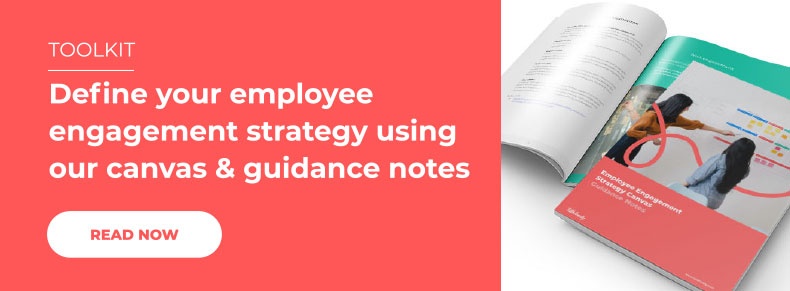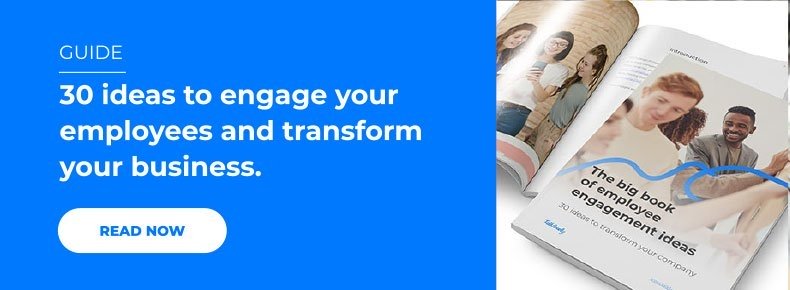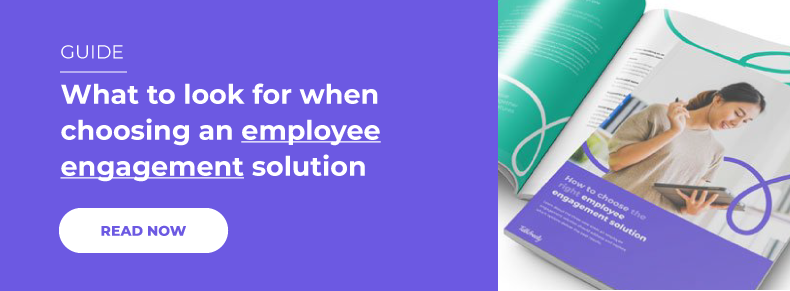What percentage of your employees are currently at their desks? It’s very unlikely to be 100%. Hybrid working has become a prominent feature of office life, with more and more of us working from home at least one day a week. Connecting with these remote workers has become a critical issue that can’t be ignored. While hybrid working has many positives, it can pose some challenges. Employee engagement is one of the first areas to suffer a knock-back.
According to the latest government research, around one in five of the GB workforce worked from home at least one day a week. And around one in eight are working from home exclusively. The hybrid setup has been welcomed by the majority of employees too. Gartner confirms this. Recent studies reveal that over two-thirds of job candidates currently working onsite would prefer to work in a hybrid or remote model. And 97% of hybrid or remote workers prefer working in hybrid or remote models.
It’s clear that hybrid working is here to stay. With companies keen to maintain high levels of employee engagement and motivation, it’s time to embrace the change and make it work for us.
In this blog, we look at the key drivers of employee engagement and apply them to the hybrid working scenario. We consider how to engage employees when they are no longer solely officed-based and whether our current channels of communication need adapting to this new version of office life.
The Challenges of Hybrid Working
First, we have to ask why is employee engagement important? With the current economic uncertainty, many businesses are just focusing on staying afloat. So it’s not surprising that employee engagement often finds itself at the bottom of the priority list. However, this is a serious oversight. Without engaged employees, a company will quickly see lower morale, a decrease in productivity and ultimately, a downturn in profits.
When you throw hybrid working into the mix, it becomes even more essential to understand what drives employee engagement and why it matters. The lack of face-to-face contact makes it harder to monitor and maintain engagement levels, and daily interaction becomes much more of a challenge. Without these key drivers of employee engagement in play, morale takes a hit.
One of the key barriers to employee engagement is the lack of direct supervision that comes with homeworking. This can leave employees feeling unsupported and less confident in their abilities. Newer employees can struggle due to a lack of information or guidance, while others may drop their productivity levels without close supervision.
Developing and maintaining a workplace culture is also challenging from a distance. One of the crucial employee engagement best practices is to implement a solid company ethos, but this is harder to achieve without social conversation and face-to-face interaction. Without feedback, it is also hard to monitor whether the company culture is being transmitted and understood.
Finally, there’s the issue of isolation. This is not to be underestimated. We are social creatures by nature, and it’s hard to satisfy our psychological need for human interaction over a screen. Without those daily conversations and informal chats between colleagues, morale and mental health can take a severe nosedive, and work engagement will soon follow suit.
Principle Drivers of Employee Engagement
Hybrid working is presenting a new challenge for internal communications. What’s needed is a fresh look at our employee engagement strategy to ensure that it is robust and flexible enough to cope with these fresh demands. Here, we look at the drivers of employee engagement and consider how they should be fine-tuned to best meet the needs of your hybrid employees.
#1 Wellness
The physical and mental health of employees is one of the top drivers of employee engagement
The Global Wellness Institute defines wellness as “the active pursuit of activities, choices and lifestyles that lead to a state of holistic health.” The concept of wellness has become popular in business circles in recent years, but it is far more than merely a buzzword; focusing on wellness can have an impressive influence on the engagement of your employees.
Wellness is especially relevant for hybrid workers, especially emotional wellness. Mental health is a serious issue and can negatively impact engagement levels. Employee engagement statistics back this up. According to Deloitte, 50% of employees have experienced at least one characteristic of burn out due to greater job demands and expectations, lack of social interaction and lack of boundaries between work and home life.
If mental health and morale are left unchecked, this will quickly lead to disengagement with both the role and the company as a whole.
By focusing on wellness, you are taking the chance to see your employees holistically. Employees who are content and satisfied outside the office environment will be more inclined to bring their ‘best selves’ to the business. Research shows that sickness due to mental health costs the UK economy over £8 billion per year, so investing in wellness and employee well-being carries significant benefits for both businesses and workers. It is important to ensure that attention to health is more than mere lip service. It needs to be a core aspect of your working culture to help drive engagement.
#2 Learning and Performance
Continue to provide development opportunities; one of the key employee engagement drivers
Offering chances for growth, development and education are top employee engagement drivers. Employees need to receive the appropriate training to allow them to do their job with confidence. Uncertainty and confusion will inevitably lead to reduced performance. By offering your staff relevant, up-to-date training, you are showing them that you see them as an investment. This, in turn, will boost their feeling of value to the company, giving them the incentive to remain motivated and engaged.
Make sure these critical employee engagement initiatives are still available to all employees, especially your hybrid and remote workers. By encouraging continued training and development, you’ll reassure employees that their roles are continuing to move forward. This is an ideal opportunity for hybrid workers to add to their skills base. Qualifications drive employee engagement. They show that you are making a commitment to a long-term investment in a team member - a great way to demonstrate appreciation, and foster commitment.
Innovation is also connected to learning and performance. When employees have a solid base, they are more likely to take risks and voice opinions and ideas. An employee app is a simple way to introduce a culture of ideas and innovation. Tailor-made modules make it easy to post business challenges, capture ideas and encourage peer-to-peer discussion. It’s the perfect way to keep your hybrid workforce fully engaged and connected to their role and the broader company goals.
#3 Rewards and Benefits
Remember that incentives and benefits are principal drivers of employee engagement
Rewards and benefits are key features of the employer/employee relationship and are a great way to help staff feel seen and valued. When given the incentive to work hard, employees are likely to find doing so more appealing. Research shows that those employees who are happy with their benefits and rewards offered by their workplace are up to a fifth more engaged than those who are less satisfied. A clearly defined system of rewards and benefits is a great way to improve employee engagement.
With managers no longer working from a nearby desk or office, it’s harder to implement rewards in the usual manner. However, it’s essential that remote and hybrid workers don’t feel their efforts go unseen and unappreciated. By regularly monitoring and reporting on progress, it’s possible to keep reward schemes on track, wherever your team are located.
It is important to note that if such a system is implemented, it needs to be clear, consistent, and transparent. A rewards system which is unreliable, unclear, or perceived to be unfair will have the opposite impact, fostering mistrust and a ‘why bother’ attitude in employees. It also needs to be relevant; think about what would improve the lives of your employees and use these features to build the system.
Done well, reward schemes are particularly suited to work in the hybrid set-up and can be one of the critical drivers of employee engagement.
#4 Collaboration
Social spaces are surprisingly effective drivers of employee engagement
Collaborative working is a crucial factor when it comes to understanding what drives employee engagement. Remember that in most cases, the workers on the ground will have better day-to-day knowledge and understanding of their role and the potential impact of any changes or adaptations. This can give them a unique insight into how best to implement changes that will work.
Collaboration has been hit hard by the switch to remote and hybrid working. It’s no longer easy to enjoy a quick brainstorming across the desks or schedule an impromptu meeting. However, just because physical interaction isn’t always possible, don’t let collaboration fall by the wayside. An employee engagement platform will allow everyone to contribute – effortlessly. Conversation modules enable employees to meet, chat and share their knowledge and ideas – whether they’re sitting opposite or on the other side of the country.
Accountability is a significant point to consider when it comes to collaboration; there is no sense in asking for feedback and assistance if the results are merely ignored. Employees need the tools, space, and trust to collaborate effectively. This will inspire them to remain engaged and continue to come up with new ideas and concepts. Having more of a stake in the business will boost loyalty, drive engagement and help them to feel that they are part of a complete team. Restoring that sense of a cohesive team is one of the most important drivers of employee engagement.
#5 Strategic communication
Reliable channels and instant notifications are key employee engagement drivers
Strategic communication is one of the top employee engagement drivers. It allows workers at all levels to see the bigger picture, offering them greater motivation to work as part of the wider team; they can see the desired end goal, and feel part of the narrative of the business. It’s a crucial element of any employee engagement model.
Strategic narrative relies primarily on strong communication and keeping employees in the loop. This is especially relevant for hybrid workers who won’t have access to some of the usual channels when they are working from home. Any news or updates should be readily communicated and made public knowledge as soon as possible to help boost engagement. Employees need to feel that they are an active part of an evolving story, rather than come across out-of-date information months later.
How to manage this effectively for a dispersed hybrid workforce? You need to be able to connect with staff wherever they are; at home, at the office or on the move. An employee engagement app will help bridge this gap. It removes barriers by allowing employees to use their own devices and will circulate messages across the company flawlessly. Make sure your app offers instant notifications. These are a must-have for the hybrid work model, ensuring everyone gets the same message simultaneously.
#6 Leadership
One of the top drivers of employee engagement? Visible leadership
For employee engagement to be facilitated throughout the organisation, it is imperative that those at the top show strong, dynamic and engaging leadership. The impact of leadership on employee engagement is well documented, and this can be a real game-changer when considering how to drive engagement. It’s at the heart of every employee engagement theory. And when it comes to hybrid working, leaders have a hugely important part to play.
In times of change and uncertainty, leaders really need to step up their game. It’s essential for all employees, especially those working from home, to have a visible leadership figure to turn to. Listening is also crucial. A strong employee listening strategy, offering a two-way internal communication channel, will help you to deliver on mutual goals and measurable targets.
A poor leader will never garner the respect of those in their care. In turn, these workers will become demotivated and frustrated, negatively impacting their overall work engagement. Strong leaders create strong teams - both essential ingredients for effective engagement.
#7 Employee Voice
Free-flowing feedback channels are the drivers of employee engagement
For employees to feel engaged, they need a voice. However, once an employee is working
away from the main office, it’s easy for them to feel silenced and ignored. One of the most important drivers of employee engagement is the creation of free-flowing feedback channels.
Once you give back that all-important employee voice, engagement levels quickly rise amongst your dispersed workforce.
For many business leaders, it may have been several years since they worked ‘on the floor,’ completing the same role as many of their team members. This can result in a disconnect; many of your amazing employee engagement ideas could fall flat or be unworkable in practice. This can result in disengagement; the workers feel they have no voice and are not being listened to, so they become disillusioned and unmotivated. Equally, remote workers can find it challenging to make their voices heard above those based at the office.
The best way to implement effective feedback channels is by providing employee engagement tools. These will allow you to create regular polls and surveys and provide social spaces for comments and ideas. By allowing your employees to speak, you can get the best from them and make practical, helpful changes that can revolutionise your business for the better.
#8 Recognition
A positive culture of recognition is among the principle drivers of employee engagement
For many workers, a sense of powerlessness can lead to a lack of engagement. Recognition is a simple change you can make, which can impact the engagement levels of your workforce. A simple acknowledgement can significantly impact your staff's mood, attitude, and motivation, helping them feel valued and appreciated in their role.
It is clearly harder to acknowledge outstanding work when your employee is based at their kitchen table rather than the other side of your desk. However, just because your employees are physically present doesn’t mean that recognition should be side-lined. It’s still possible to send an email acknowledging extra effort, remembering to copy in the team for that all-important public approval. Hybrid working should be no impediment to recognition.
An employee app will make it even simpler to recognise success. In-built modules allow for both manager-led recognition and peer-to-peer appreciation. It will enable you to celebrate successes over social spaces, and include teams, departments or the entire company if required. Take the time to voice your appreciation when things go well. This sort of investment and recognition inspires confidence, a great ingredient when you are looking to drive employee engagement.
And Don’t Forget to Measure Your Results
A key aspect of employee engagement is having a system which allows you to measure engagement levels. Set out your drivers of employee engagement, and then monitor them closely. This is crucial in understanding which concepts and ideas are working, and where changes need to be made or tweaked. Measuring progress also allows you to prove to employees that you are actively seeking to improve, and are responding in a dynamic, flexible way.
Connecting With the Hybrid Workforce is Possible…
As long as you put the right drivers of employee engagement in place. By ensuring your employee engagement initiatives have been reassessed and reimagined to reach out to your hybrid workers, there’s no reason why you shouldn’t be successful. Your aim is to bring your dispersed teams back together, working as a single cohesive unit.
A team with disengaged workers will be fractured and less productive, and results in every member performing to less than their full potential. This is bad news for business. Engaged employees are a vital business asset. At the core, the more engaged the team member, the more they will see themselves as a smaller part of a wider, collective whole. This is at the centre of engagement. Only by working as one team, towards a common goal, can a business really thrive and evolve.










.jpg)
.jpg)